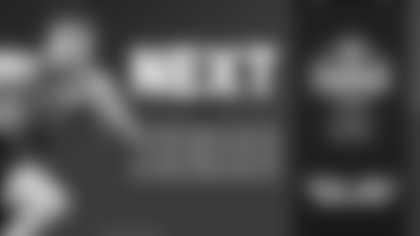Bigger DTs One Area in 2009 NFL Draft where Polian said
Colts "Broke the Mold"
INDIANAPOLIS – The trend led directly to the decision.
Bill Polian, in his 12th season as the Colts' president, said when reviewing the 2008 season – the team's seventh consecutive playoff season and ninth in 10 seasons – a trend became obvious. It was, Polian said, obvious enough it needed to be addressed in a big way.
A really big way.
Polian, when examining the team's run defense and how it affected the Colts' overall approach to games, said what was on film led to a shift in philosophy, one he said could be seen in this past weekend's 2009 NFL Draft.
Polian said the Colts got bigger up front defensively.
And that, Polian said, was by necessity.
"We felt like we wanted to be better against the run up front, particularly at the tackle position," Polian said shortly after the draft concluded Sunday. "We did that, and we've done more of that, I think, in (collegiate) free agency."
Polian said the move to get bigger at the position signified the lone significant change in draft-day approach.
"We didn't have to break the mold in any way other than saying, 'Hey, we recognize we need to get bigger at the defensive tackle spot," Polian said.
Jim Caldwell, in his first season as the head coach after seven years as an assistant said improving both the run defense and run offense – was a pre-draft objective.
"We talked about the things we needed to get done, and that was obviously secure a situation where we could feel that could go in and be able to run the ball a little bit better, then also be able to stop the run," Caldwell said. "We certainly put ourselves in position to do that."
The Colts, after playing much of last season with two defensive tackles weighing more than 300 pounds – preseason waiver-acquisition Dan Muir and midseason free-agent signee Antonio Johnson – over the weekend selected two 300-pound-plus defensive tackles:
• Fili Moala (6-feet-4, 303 pounds), Southern California. The Colts traded their 2009 fifth-round selection to Miami to move up to the No. 56 selection to acquire Moala, who started 38 of 52 games for Southern Cal, a total that included his last 33 games. Moala finished his Southern Cal career with 90 tackles, including 30 this past season. He had 9.5 sacks at Southern Cal and 23.5 tackles for loss. "What I provide is athletic ability, strength and point of attack," he said. "I know I have a motor and can run with the best of them. Those are qualities that have gotten me to this point in my career."
• Terrance Taylor (6-0, 319), Michigan. The Colts selected him with their second fourth-round selection, the No. 136 selection overall. He started three seasons at nose tackle for Michigan, starting 36 games and registering 17.5 tackles for losses and six sacks. He had four tackles for losses and 1.5 sacks this past season as a senior. "A run-stopper," Taylor called himself Sunday.
Polian said the addition of a true nose tackle was a necessary move.
"That's something we felt like we needed to add in terms of how we structure the defense, and he was the prototypical nose tackle," Polian said.
The Colts this past season finished 24th in the NFL in rushing defense, allowing 122.9 yards a game, but Polian said there was more to the decision to draft bigger defensive tackles than just statistics. Polian said this past season a trend that had developed in seasons past continued, with teams often running with the objectives to wear down the Colts' defense and limit the Colts' offensive possessions.
A notable instance, he said, was a late-season victory at Cleveland in which the Browns produced just 193 total yards, but ran 32 times for 101 yards and held a 32:14-27:46 time-of-possession advantage. Indianapolis needed a fourth-quarter fumble return by defensive end Robert Mathis for a 10-6 victory.
"They were quite happy to win 6-3," Polian said. "They happened to lose, 10-6. People were beginning to look at that as a victory, so to speak, if they kept (Colts quarterback) Peyton (Manning) off the field. They battered and bashed our defense. After a while, the physical toll was beginning to show – the number of plays you're out there. Those kinds of things were a trend we felt was starting to take its toll. We made a commitment using the same defensive philosophy to try and get athletic players, but who were bigger.
"Don't forget. Our defense was at its best when we had Booger McFarland (in 2006) and Corey Simon (in 2005) both 300-plus pound guys.
"It's very tough for the smaller guys to stand in there 16 or 19 games and take that."














